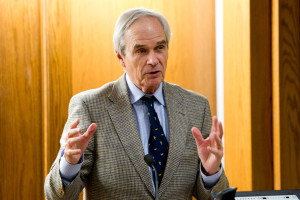
Civil service reformers should consider changes to lengthy, single-agency employee tenures.
A decade ago, in Outsourcing Sovereignty, Paul R. Verkuil established himself as the most forceful academic critic of the “contracting out” of what he saw as non-delegable governmental functions. Verkuil has returned to this subject in Valuing Bureaucracy: The Case for Professional Government. This time, his main concern is the federal civil service—largely the civil service as he got to know it up close while chairing the Administrative Conference of the United States (ACUS). I will focus my comments here accordingly, at the risk of slighting many of the important contributions of this short but wide-ranging and excellent book. These include Verkuil’s trenchant criticism of the ever-growing “contractor state” that ought to be an embarrassment to small-government conservatives.
Verkuil’s concern is the upper stratum of the federal career bureaucracy, which “steers” rather than “rows” government programs, especially the beleaguered Senior Executive Service. Verkuil argues, at his most ambitious, that the best members of the career bureaucracy can and often actually do perform the work of government better—even more efficiently—than contractors.
Before saying why, it bears emphasizing that Verkuil’s argument is not the sort one commonly encounters from academic lawyers. One is much more likely to hear from them that civil servants “check…the partisan and ideological excesses of the elected administrations,” secure fealty to legal obligations, or perform some other such rule-of-law function that has no real private sector analogue—even if, and sometimes precisely because, they can render government inefficient.
But this is not the Verkuil of Valuing Bureaucracy. He is less interested in constraining the administrative apparatus of the executive branch than in empowering it to implement whatever programs Congress puts in place. An important caveat: What those programs should be does not concern him. He is not, he emphasizes, arguing for “big government.”
Readers not familiar with Verkuil’s career should keep in mind that he has distinguished himself both as a legal scholar of first rank and as a university and then government administrator who has been quick to complain when a nettlesome and second-rate lawyer unnecessarily gets in the way of business. “Get me a green-light lawyer,” he has sometimes been heard to say.
Professional civil servants, according to Verkuil, offer a form of “expertise” that comes from long tenures in government—made possible by legal protection against politically motivated discipline and discharge—and the attendant bureaucratic “autonomy.”
“Nowhere is this professional expertise more needed,” Verkuil argues, “than in cutting through the spider’s web of rules and formalities” that “deprive citizens of the benefits” of government programs—in short, in cutting through “gridlock.” Hence the book’s front cover: Maurice Sterne’s painting Red Tape, which depicts Oliver Wendell Holmes on horseback, sword in hand, “fighting bureaucratic entanglements” that are represented as a giant spider web.
These “rules and formalities” have been “created unintentionally by decades of encrusted statutory and regulatory commands directed” at agencies “from many directions,” and there are no readily available legislative or administrative ways to eliminate them. So they must sometimes be worked around. Verkuil argues that it is often only civil servants who possess the institutional knowledge to identify what he calls workarounds, and he credits them with answering the call of political appointees for workarounds “hundreds of times a day.”
No doubt some lawyers will reject Verkuil’s self-described “workaround theory” as an invitation to lawlessness—especially upon hearing that he connects it (albeit tentatively) to Harvard Law School Professor Adrian Vermeule’s scary sounding, but often misunderstood, theory of “the optimal abuse of power.” But that would be a mistake. Government officials must reckon with the messy realities of what Columbia Law School Professor Gillian Metzger and Vanderbilt Law School Professor Kevin Stack have called “internal administrative law” if they are to carry out faithfully their obligations to the public rather than just push paper and collect a paycheck. One such reality, Verkuil emphasizes, is that legal rules governing internal administrative action often “conflict.”
To which I would add: There are rules and then there are rules. Not all of them should equally command the bureaucrat’s allegiance. The administrative rules governing internal agency action include not only actual regulations, but also an ever-proliferating number of sub-regulatory pronouncements emanating from all different levels in the administrative hierarchy that are only loosely tethered, if tethered at all, to any statute or regulation. Many come with no legal sanctions for non-compliance.
The point here is that choices must be made all the time as to whether, when, and how to follow this or that rule, and officials must choose well if scarce administrative resources are to be allocated in the public interest.
If Verkuil goes wrong in any respect here, it is in having too much faith in our civil servants to undertake the red-tape-cutting role he would assign them. Many are just too cautious and timid. Whatever their dispositions upon entering the government, they soon become socialized into a system that reinforces and rewards cautiousness and timidity. They are also often too protective of their own agency’s turf, which is a real problem in a fragmented bureaucracy that depends on interagency cooperation and coordination. Verkuil acknowledges these problems, but only up to a point and then only grudgingly.
Verkuil might also have noted another, related problem, this one arising in part from long careers in a single agency. Many civil servants work in cloistered and self-referential interpretative communities. A common result is that they stand resolutely on entrenched agency interpretations of rules—not all of them even reasonable, let alone compelled—that can deprive the system (often other affected agencies) of the flexibility to respond to new circumstances and embrace suggestions for better ways of doing things. There is seldom effective recourse to outside interpreters—federal judges, lawyers at the U.S. Department of Justice’s Office of Legal Counsel, officials at OMB—to tell an agency that its own interpretation of the law may not be the only, the best, or even a reasonable one.
There is, finally, the issue of basic competency. There are many outstanding civil servants; Verkuil even names a few. But far too many more are insipid careerists who are neither very able, nor as well-credentialed as their private sector counterparts, nor nearly as hard working as the public should expect. These are, admittedly, just my impressionistic assessments of the civil service from a short stay in government, but so, too, are Verkuil’s more generous ones. I will defer to the empirical research if and when it arrives.
While Verkuil may be too reluctant to pass judgment on our civil servants, he does not, thankfully, hold back much on the civil service system. His indictment is well-delivered and well-deserved. Problems abound—some of them the result not of the civil service laws themselves, but of the perverse ways those laws have been interpreted and applied by OPM officials and their like-minded counterparts in agencies.
Among them: Hiring top employees can be near impossible. One problem Verkuil highlights is that OPM officials think they know better than hiring managers what skills a job requires and who among applicants possess them, and they cabin hiring discretion accordingly. Terminating underperforming employees is still harder, in part the result of excessive and miscalibrated just-cause protections that serve the interests of employees rather than the public. And the compensation system is a mess. Some employees are overcompensated, many more undercompensated. Salary compression may be yet a more serious problem. Congress’s promise of merit pay in the Civil Service Reform Act of 1978 remains to be delivered.
Valuing Bureaucracy is surely one of the very best accounts of these and other problems to appear in recent years. Another is an outstanding recent report of a panel, chaired by Don Kettl, convened by the National Academy of Public Administration.
Never just a spectator and always an infectious optimist, Verkuil has taken the cause of civil service reform to leading think tanks and good government advocates in Washington. I would urge them, as they work through the many intricacies of reform, to recognize the disadvantages, as well as the advantages, of long tenures in the government generally and single agencies in particular. That could mean identifying alternative personnel practices—among them the hiring of experienced private sector employees for limited stays in government, much greater reliance on so-called special government employees who work on discrete projects as government employees while simultaneously holding private sector jobs, and the rotation of employees among agencies—that our civil service system seldom encourages and sometimes does not permit at all.
This essay is part of a nine-part series, entitled Valuing Professional Government.




